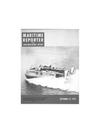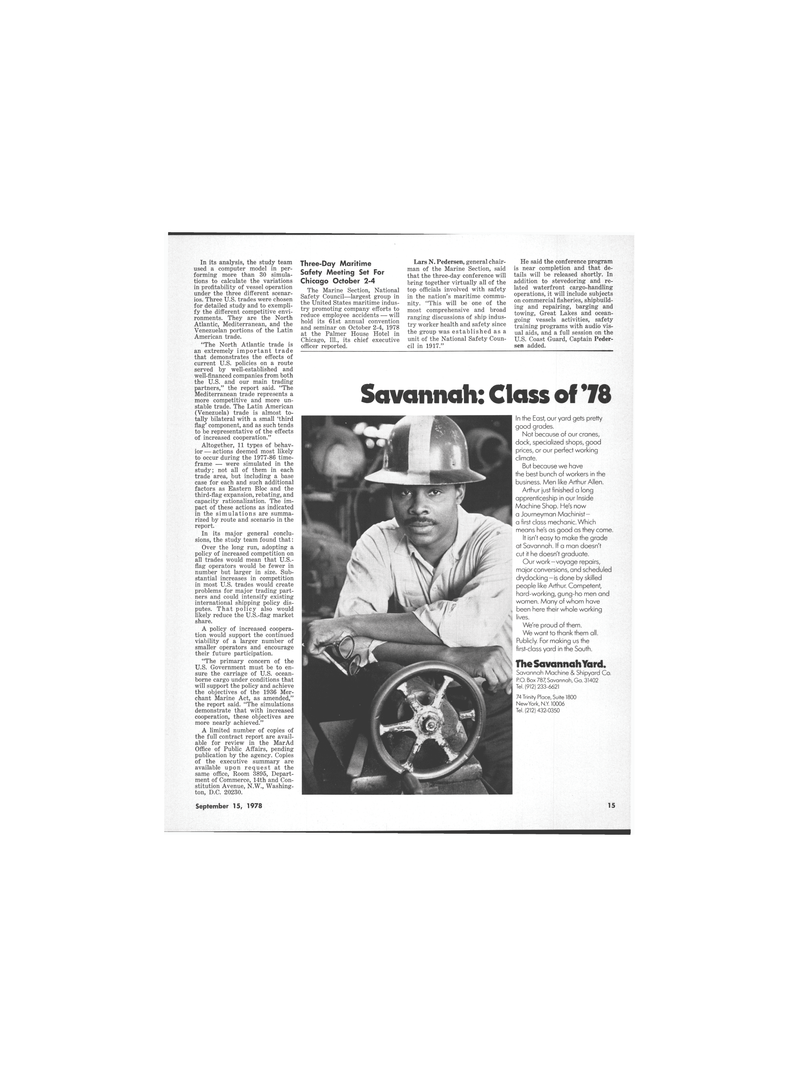
Page 15: of Maritime Reporter Magazine (September 15, 1978)
Read this page in Pdf, Flash or Html5 edition of September 15, 1978 Maritime Reporter Magazine
In its analysis, the study team used a computer model in per- forming more than 30 simula- tions to calculate the variations in profitability of vessel operation under the three different scenar- ios. Three U.S. trades were chosen for detailed study and to exempli- fy the different competitive envi- ronments. They are the North
Atlantic, Mediterranean, and the
Venezuelan portions of the Latin
American trade. "The North Atlantic trade is an extremely important trade that demonstrates the effects of current U.S. policies on a route served by well-established and well-financed companies from both the U.S. and our main trading partners," the report said. "The
Mediterranean trade represents a more competitive and more un- stable trade. The Latin American (Venezuela) trade is almost to- tally bilateral with a small 'third flag' component, and as such tends to be representative of the effects of increased cooperation."
Altogether, 11 types of behav- ior — actions deemed most likely to occur during the 1977-86 time- frame — were simulated in the study; not all of them in each trade area, but including a base case for each and such additional factors as Eastern Bloc and the third-flag expansion, rebating, and capacity rationalization. The im- pact of these actions as indicated in the simulations are summa- rized by route and scenario in the report.
In its major general conclu- sions, the study team found that:
Over the long run, adopting a policy of increased competition on all trades would mean that U.S.- flag operators would be fewer in number but larger in size. Sub- stantial increases in competition in most U.S. trades would create problems for major trading part- ners and could intensify existing international shipping policy dis- putes. That policy also would likely reduce the U.S.-flag market share.
A policy of increased coopera- tion would support the continued viability of a larger number of smaller operators and encourage their future participation. "The primary concern of the
U.S. Government must be to en- sure the carriage of U.S. ocean- borne cargo under conditions that will support the policy and achieve the objectives of the 1936 Mer- chant Marine Act, as amended," the report said. "The simulations demonstrate that with increased cooperation, these objectives are more nearly achieved."
A limited number of copies of the full contract report are avail- able for review in the MarAd
Office of Public Affairs, pending publication by the agency. Copies of the executive summary are available upon request at the same office, Room 3895, Depart- ment of Commerce, 14th and Con- stitution Avenue, N.W., Washing- ton, D.C. 20230.
Three-Day Maritime
Safety Meeting Set For
Chicago October 2-4
The Marine Section, National
Safety Council—largest group in the United States maritime indus- try promoting company efforts to reduce employee accidents — will hold its 61st annual convention and seminar on October 2-4, 1978 at the Palmer House Hotel in
Chicago, 111., its chief executive officer reported.
Lars N. Pedersen, general chair- man of the Marine Section, said that the three-day conference will bring together virtually all of the top officials involved with safety in the nation's maritime commu- nity. "This will be one of the most comprehensive and broad ranging discussions of ship indus- try worker health and safety since the group was established as a unit of the National Safety Coun- cil in 1917."
He said the conference program is near completion and that de- tails will be released shortly. In addition to stevedoring and re- lated waterfront cargo-handling operations, it will include subjects on commercial fisheries, shipbuild- ing and repairing, barging and towing, Great Lakes and ocean- going vessels activities, safety training programs with audio vis- ual aids, and a full session on the
U.S. Coast Guard, Captain Peder- sen added.
In the East, our yard gets pretty good grades.
Not because of our cranes, dock, specialized shops, good prices, or our perfect working climate.
But because we have the best bunch of workers in the business. Men like Arthur Allen.
Arthur just finished a long apprenticeship in our Inside
Machine Shop. He's now a Journeyman Machinist- a first class mechanic. Which means he's as good as they come.
It isn't easy to make the grade at Savannah. If a man doesn't cut it he doesn't graduate.
Our work-voyage repairs, major conversions, and scheduled drydocking—is done by skilled people like Arthur. Competent, hard-working, gung-ho men and women. Many of whom have been here their whole working lives.
We're proud of them.
We want to thank them all.
Publicly. For making us the first-class yard in the South.
The Savannah Yard.
Savannah Machine & Shipyard Co.
P.O. Box 787, Savannah, Ga. 31402
Tel. (912) 233-6621 74 Trinity Place, Suite 1800
New York, N.Y. 10006
Tel. (212) 432-0350
Savannah: Class of 78
September 15, 1978 15

 14
14

 16
16
